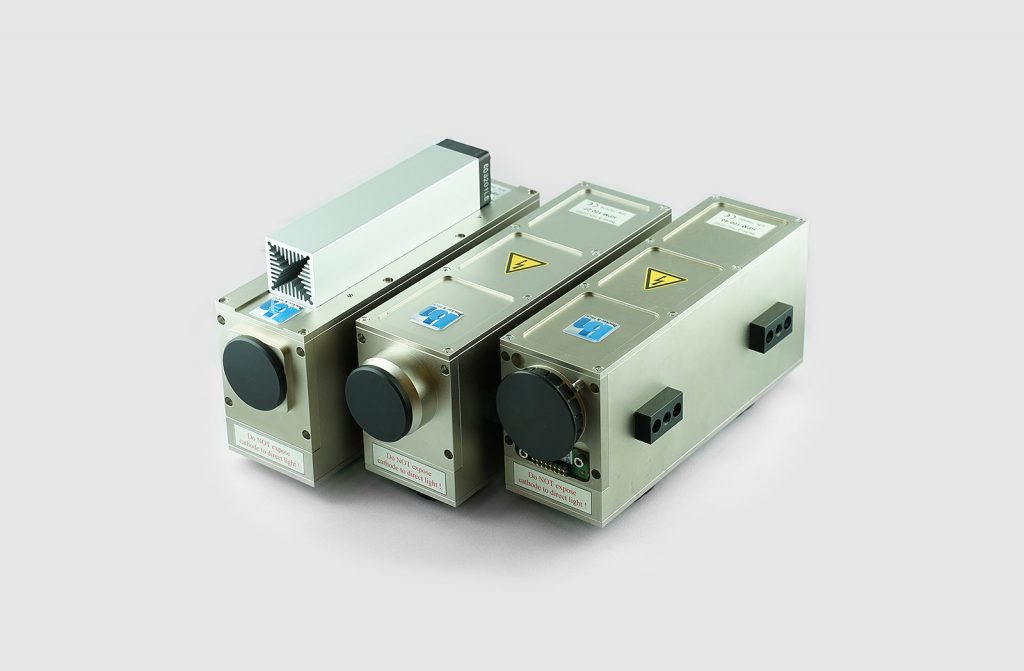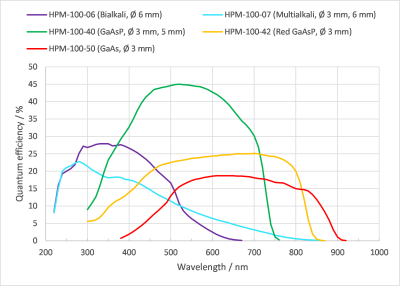
- Extremely Fast Response
- Instrument Response Function (IRF) Down to 18 ps FWHM
- High Detection Efficiency
- Large Active Area: 3 mm or 6 mm Cathode Diameter
- Five Cathode Types Covering 180 nm to 920 nm (Click Here to Compare Spectral Sensitivity)
- No Afterpulsing Background
- No Afterpulsing Peak in FCS Measurements
- Extremely High Dynamic Range of TCSPC Measurements
- Clean IRF: No Tails or Secondary Peaks
- High Noise Immunity
- Internal Generators for PMT Operating Voltages
- Power Supply and Control via DCC-100 or DCU-400/DCU-800
- Overload Protection
- Direct Interfacing to All bh TCSPC Systems
- Cooled Version with Reduced Dark Count Rate Available
Specifications
|
|
HPM-100 |
||||
|
Cathode Type |
-06 |
-07 |
-40 |
-42 |
-50 |
|
Wavelength Range / nm 1) |
220 - 650 |
220 - 850 |
250 - 720 |
300 - 850 |
400 - 900 |
|
Detector Quantum Efficiency 1) |
28 % @ 400 nm |
26 % @ 290 nm, 18 % @ 400 nm |
45 % @ 500 nm |
22 % @ 500 nm |
20 % @ 600 nm |
|
|
Spectral sensitivity: click here |
||||
|
Dark Count Rate (typ. Value)/ s-1, Tcase = 22 °C |
15 |
< 300 |
400 |
700 |
1100 |
|
Dark Count Rate for Actively Cooled HPMs (typ. Value)/ s-1, Tcase = 30 °C |
< 15 |
< 150 |
100 |
320 |
400 |
|
Transit Time Spread (TCSPC IRF / FWHM, typ Value) |
< 20 ps |
120 ps |
150 ps |
170 ps |
|
|
Max. Count Rate (Continuous) |
> 10 MHz |
||||
|
Single Electron Response Width (FWHM, typ. Value) |
850 ps |
||||
|
Single Electron Response Amplitude (Vapd 95 % of Vmax) 2) |
50 mV |
||||
|
Overload Shutdown |
> 15 MHz (Higher rates on request) |
||||
|
Signal Output |
|
||||
|
Output Polarity |
negative |
||||
|
Output Connector |
SMA |
||||
|
Output Impedance |
50 Ω |
||||
|
Power Supply |
|||||
|
(from DCC-100 Card) |
+12 V, +5 V, -12 V |
||||
|
General |
|||||
|
Cathode Diameter |
6 mm |
3 mm |
3 mm |
3 mm |
3 mm |
|
Dimensions (Width x Height x Depth) |
(60 x 90 x 170) mm |
||||
|
Optical Adapter |
C-Mount, DCS-120, LSM 710/780/880 NDD and BIG port |
||||
|
All HPM-100 Detectors are available as Cooled Versions |
|||||
(1) According to Hamamatsu specifications
(2) Varies with cathode type and manufactering lot
Downloads
Documents
Related Literature:
- W. Becker, B. Su, K. Weisshart, O. Holub, FLIM and FCS Detection in Laser-Scanning Microscopes: Increased Efficiency by GaAsP Hybrid Detectors. Micr. Res. Tech. 74, 804-811 (2011)
Applications
Application Notes
- Detectors for High-Speed Photon Counting
- Timing Stability of TCSPC Experiments
- bh FLIM Systems for Nikon C1 Scanners
- Non-Descanned FLIM Systems for Olympus FV-1000 and FV-300 Multiphoton Microscopes
- The HPM-100-40 Hybrid Detector
- Recording Z Scans with the DCS-120 Confocal Scanning FLIM System
- Tuneable Excitation FLIM with the LSM 710 Intune System
- The HPM-100-50 Hybrid Detector: Increased Dynamic Range for DOT
- Microsecond Decay FLIM: Combined Fluorescence and Phosphorescence Lifetime Imaging
- DCS-120 Confocal Scanning System: FLIM with NIR Dyes
- Multiphoton NDD FLIM at NIR Detection Wavelengths with the Zeiss LSM 7MP and OPO Excitation
- NSOM FLIM with the Nanonics AFM/NSOM System
- Implantable Fibre-Optical Fluorescence-Lifetime Detection System for in-vivo Applications
- TCSPC Fibre-Probe System with an Exchangeable Tip
- The PZ-FLIM-110 Piezo-Scanning FLIM System
- Sub-20ps IRF Width from Hybrid Detectors and MCP-PMTs
- Ultra-fast HPM Detectors Improve NAD(P)H FLIM
- Metabolic Imaging with the DCS-120 Confocal FLIM System: Simultaneous FLIM of NAD(P)H and FAD
- Software-Integrated FLIM for Nikon A1+ Confocals
- Recording the Kautsky Effect by Fluorescence Lifetime Detection
- An AFM/NSOM System with Fluorescence Lifetime Imaging
- FLIM at a Time-Channel Width of 300 Femtoseconds
- Two-Photon FLIM of Pollen Grains Reveals Ultra-Fast Decay Component
- Two-Photon FLIM of Mushroom Spores Reveals Ultra-Fast Decay Component
- High-Resolution Measurement of NADH and FAD Fluorescence Decay with the DCS-120 MP
- Ultra-Fast Fluorescence Decay in Malignant Melanoma
- Ultra-Fast Fluorescence Decay in Scottish Whisky
- Influence of Magnetic Fields on the IRF of High-Speed Detectors for TCSPC
Principles
A hybrid photon detector consists of a photocathode, an electron acceleration system, and a silicon avalanche diode. Photoelectrons emitted by a photocathode are accelerated towards the avalanche diode by a strong electrical field and injected directly into diode material.

When an electron hits the avalanche diode it generates a large number of electron-hole pairs in the silicon. These carriers are further amplified by the linear gain of the avalanche diode. The total gain is on the order of 106, i.e. sufficient to generate a detectable current pulse at the output of the avalanche diode.
Important for TCSPC, the high acceleration voltage between the photocathode and the APD results in low transit time spread. With an acceleration voltage of 8 kV the transit-time spread of the electron time-of-flight is less than 20 ps. Hybrid detectors therefore deliver a very good time resolution in combination with TCSPC. In fact the intrinsic time jitter of the electron amplification system is so low, that the temporal instrument response function (IRF) of a hybrid detector is dominated by the dwell time of the photoelectrons in the photocathode. Detectors with GaAsP photocathodes deliver IRFs on the order of 90 to 120 ps (full width at half maximum, FWHM), detectors with GaAs photocatodes deliver IRFs of 120 to 200 ps FWHM. Bi-alkali and multi-alkali cathodes do not have noticeable electron dwell times. With the bh TCSPC devices such detectors deliver IRF widths of 16 to 20 ps FWHM.
Compared with a conventional PMT, the hybrid PMT has also an advantage in terms of counting efficiency. In a conventional PMT, a fraction of the photoelectrons is lost on the first dynode of the electron multiplication system. There are no such losses in the hybrid PMT: A photoelectron accelerated to an energy of 8 keV is almost certain to generate a carrier avalanche in the avalanche diode. With a high-efficiency GaAsP cathode a hybrid photomultiplier reaches the efficiency of a single-photon avalanche photodiode (SPAD), but with a cathode area several orders of magnitude larger.
The perhaps most significant advantage of the hybrid detector has only been recognised recently: The hybrid PMT is virtually free of afterpulsing. Afterpulsing is the major source of counting background in high-repetition-rate TCSPC applications, and a known problem in fluorescence-correlation (FCS) measurements. The absence of afterpulsing results in high dynamic-range fluorescence-decay recording, and in artefact-free recording of autocorrelation FCS with a single detector.
bh were the first to recognise the potential of hybrid detectors in TCSPC applications. bh were also the first to make the detectors applicable to TCSPC by combining the detector tube, the high-voltage generators, and the low-noise preamplifier in a perfectly shielded metal case.






















